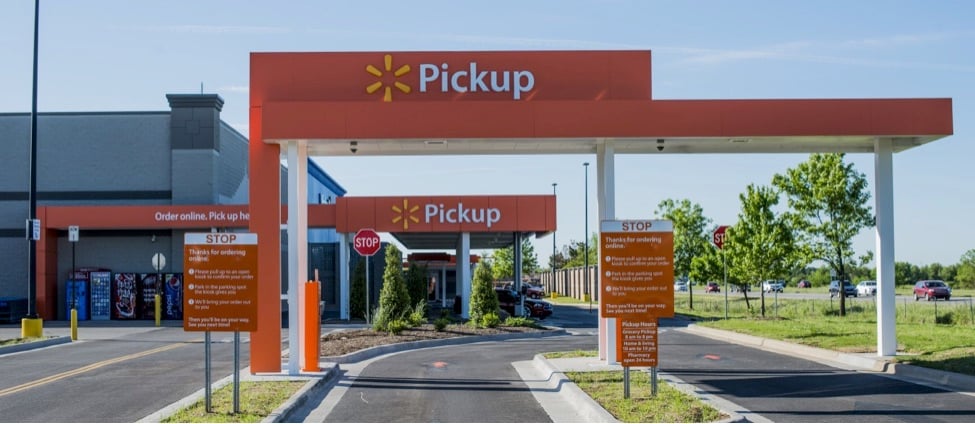
Leading omnichannel retailers are perfecting the experience of buying online and picking up in-store. Walmart, for example, is experimenting with a dedicated drive-up and parking for online customers. Source: Walmart.
The emergence of buying online and picking up in store as well as in-store returns for online purchases is driving consumer shopping expectations. But less than half of physical retailers offer these capabilities.
What follows are key factors in implementing BOPIS — buy online, pick up in-store.
On-site Promotion
It starts with awareness.
Best Buy wisely doesn’t wait until the product detail page to promote BOPIS. By integrating its offering early in the browse experience, Best Buy catches consumers in the consideration phase, presenting a compelling alternative to the convenience of Amazon Prime.
Additionally, Best Buy leverages store-specific real-time inventory to drive home scarcity — if a shopper is rushing to buy a television for the big game or to view the next episode of Game of Thrones, he better act now.
Post-sale Email
The best retailers gear confirmation emails to the BOPIS order.
These emails should include the standard order details. But they also should anticipate the needs of customers as they head to the store, such as (i) what they need to bring to retrieve their order, (ii) links to the address on maps, (iii) special parking info, and (iv) where to go inside the store.
The best examples include a photo or other visual of what customers should look for when entering the store. The goal is to streamline the experience, leaving no question unanswered.
Parking
Brick-and-mortar retailers know the value of convenient parking. It’s particularly important in dense urban areas. Dedicated parking appeals to time-starved shoppers. Moreover, BOPIS parking spots act as billboards, advertising the capability for more traditional shoppers.
In the Store
Early versions of the BOPIS experience were often poorly executed. Consumers had to stand in checkout lines to track down their orders. And retailers forced commission-driven sales associates to assist BOPIS shoppers.
The best retailers now create dedicated experiences for in-store pickup. These retailers can quickly retrieve the orders without diverting (and frustrating) sales associates.
Experimenting, Improving
Why have so many retailers failed to integrate ecommerce with in-store pickup? The most obvious answer is cost. It’s expensive to overhaul back-end logistics, retrofit stores, and train employees. A less obvious problem is the speed at which BOPIS is evolving. Many retailers struggle to find the best fit for them and their customers.
But innovative companies are experimenting — emphasizing the strengths of in-store shopping.
Nordstrom, a reported acquisition target of Amazon, is testing BOPIS variations from curbside pick-up to “reserve online and try in-store.” Nordstrom has also experimented with smaller, inventory-free locations — purely for pickup.
Dick’s Sporting Goods is experimenting with in-store lockers for item pickup, as is fashion retailer Express. While in-store lockers do not burden sales associates (and otherwise makes for efficient customer experiences), it arguably lessens the values of in-store visits. According to the International Council of Shopping Centers, almost two-thirds of BOPIS customers made one or more additional purchases while they were in the store. That’s a tremendous, missed opportunity if customers walk out with their orders without talking to employees.
…innovative companies are experimenting — emphasizing the strengths of in-store shopping.
If the locker experiments prove worthwhile, expect other retailers to use them — with cross-merchandising tactics. Picking up a new sweater? You might find an optional scarf in your locker to go with it.
Specialty retailers such as REI and Lululemon offer non-traditional, in-store experiences. REI offers a climbing course that explains how to use an ice axe. Lululemon’s classes let shoppers field-test yoga pants.
Online returns are another in-store merchandising opportunity. After all, those customers have demonstrated buying intent. Returning in-store allows the retailer to suggest alternatives to size, fit, or missteps of a well-intentioned gift giver.